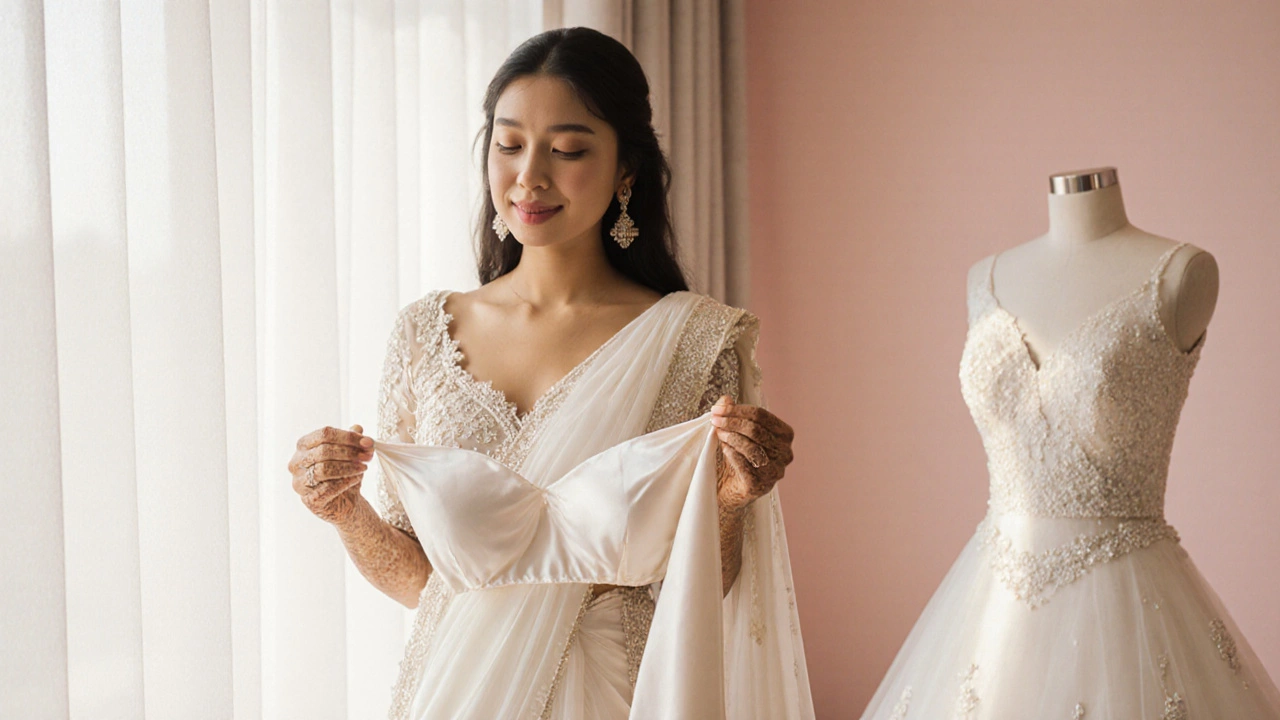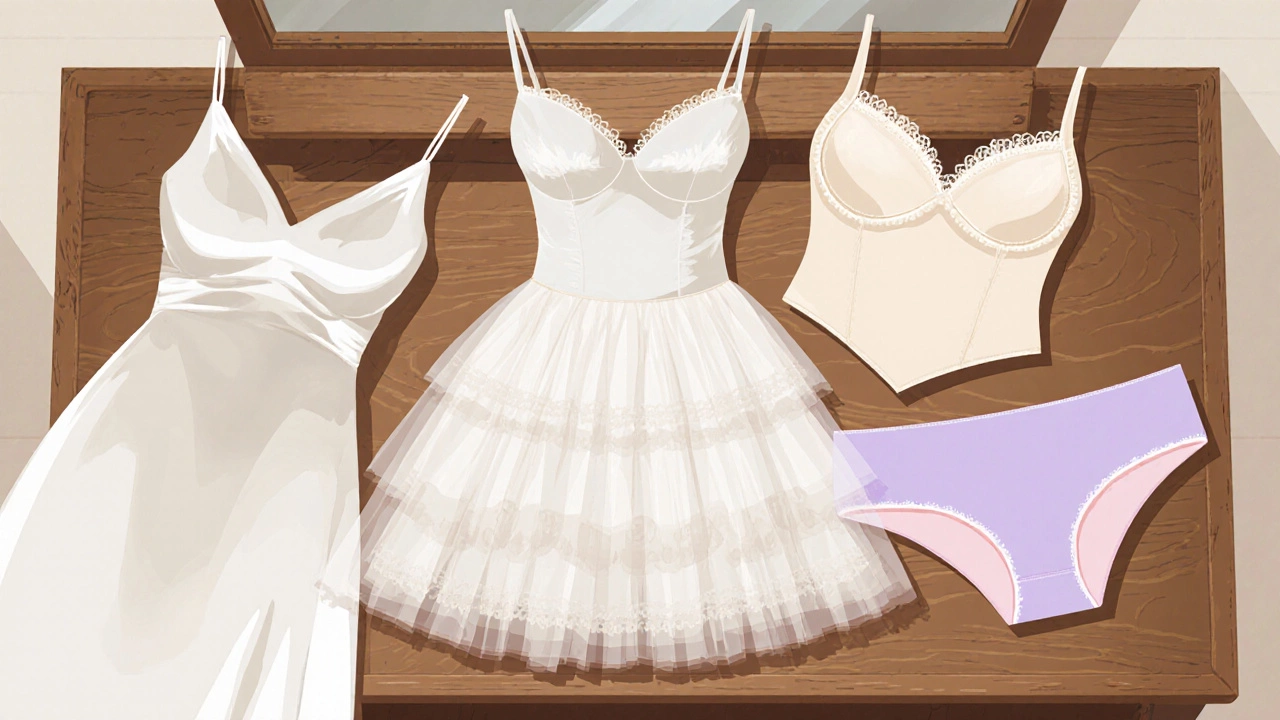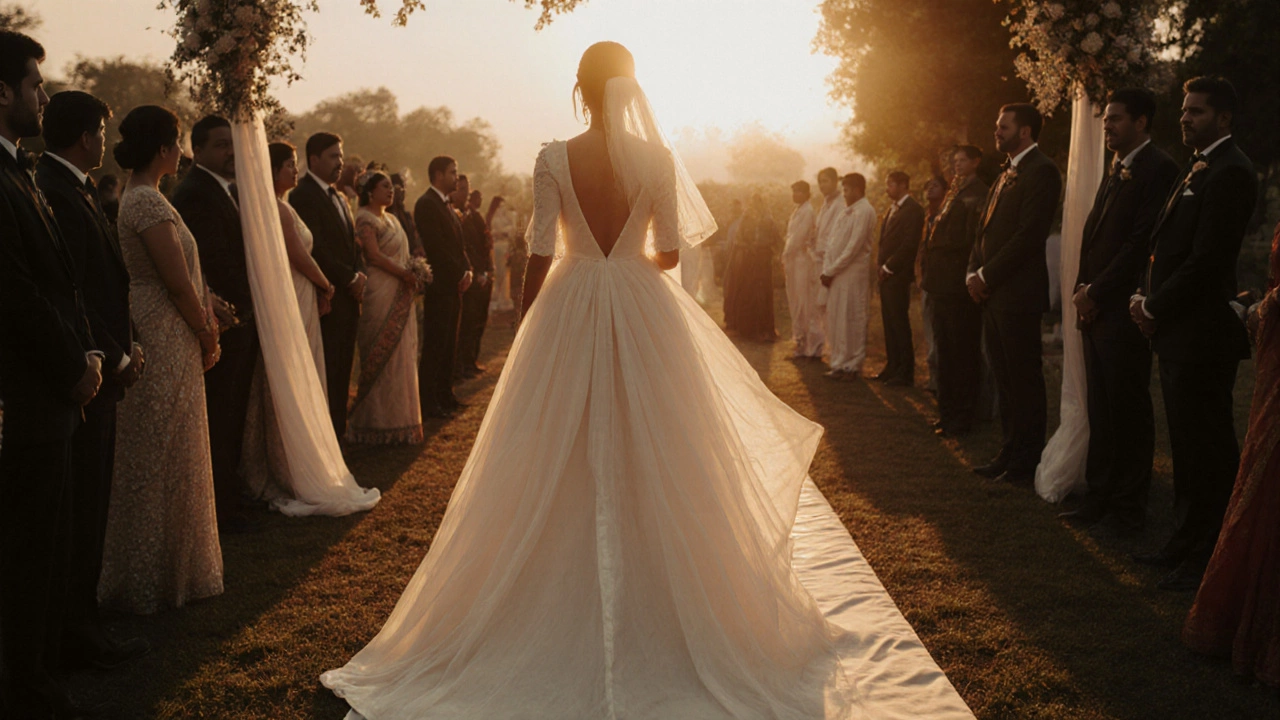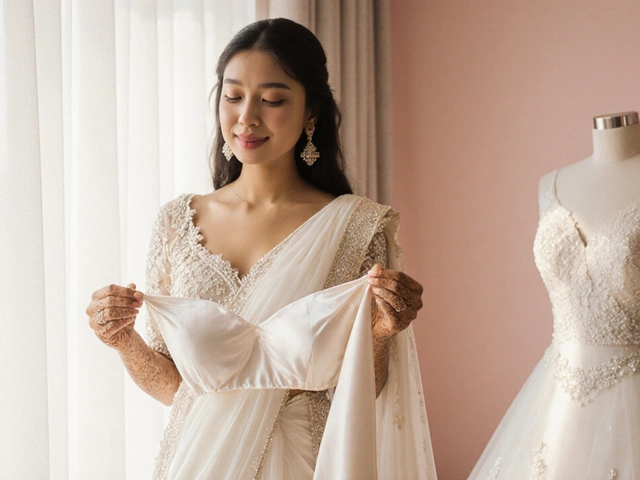
Bridal Undergarment Selector
Find Your Perfect Undergarment
Select your dress style, fabric, and special features to get personalized recommendations for the best undergarment for your wedding day.
When it comes to looking flawless beneath a wedding gown, the bridal slipa lightweight undergarment that smooths lines and adds modesty under the dress is the hidden hero many brides forget about. It’s not just an extra piece of clothing - it’s the secret that keeps a dress from riding up, prevents unwanted show‑through, and gives a polished silhouette. In this guide we’ll explore every angle of what brides wear underneath, from classic petticoats to modern shapewear, so you can pick the perfect layer for your big day.
Why Wear Something Under the Dress?
Even the most beautifully designed gown can betray a few practical issues if you skip the undergarment. Here are the three biggest reasons every bride should consider a dedicated piece:
- Modesty: Some fabrics are sheer enough that a slip prevents accidental exposure, especially when you’re moving, sitting, or dancing.
- Shape: A well‑chosen underlayer smooths out bumps, supports the bust, and can add volume where the dress needs it.
- Comfort: The right material wicks moisture, reduces friction, and can keep the dress from sticking to your skin.
Think of it as the foundation of a house - you won’t see it, but it holds everything together.
Common Types of Bridal Undergarments
Below is a rundown of the most popular options, each with its own strength.
Bridal Slip
A bridal slip is usually made from silk, satin, or lightweight polyester. It features thin straps or no straps at all, a low‑cut neckline, and a hem that sits just above the dress hemline. Bridal slip works best with fitted or semi‑fitted gowns where you want a smooth line without added bulk.
Petticoata crinkled, often tulle‑lined skirt that adds volume under ball‑gown silhouettes
Petticoats are the go‑to for princess‑style dresses. They create a full, airy shape and prevent the dress from clinging to the hips. Choose a petticoat with a built‑in crinoline if you need extra lift.
Chemisea simple, sleeveless under‑dress that provides modesty and a smooth base
A chemise is essentially a nightgown for the wedding day. It offers modest coverage without shaping, making it ideal for lightweight or flowy gowns where you don’t need extra structure.
Shapewearcompression garments that smooth the torso, hips, and thighs
Modern shapewear comes in high‑waisted briefs, bodysuits, or thigh‑concealers. Look for breathable fabrics with a 20‑30mmHg compression rating for all‑day comfort.
Seamless Underwear
If your dress has a low back or side cut‑outs, seamless nude underwear made from microfiber is the safest bet. It leaves no visible lines and feels almost weightless.
Choosing the Right Fabric
Fabric matters as much as style. Here’s a quick cheat sheet:
- Silk: Luxurious feel, temp‑regulating, but can slip on satin gowns.
- Satin: Shiny and smooth; works well under lace or beaded dresses.
- Cotton: Breathable and low‑cost; best for casual or outdoor weddings.
- Tulle: Lightweight and adds volume; perfect for petticoats.
- Microfiber: Seamless and moisture‑wicking; ideal for shapewear.

How to Fit and Try On Your Undergarments
- Measure yourself while wearing a regular bra and underwear. Note bust, waist, and hip measurements.
- Try the undergarment on its own first. Check for pinching, riding up, or visible lines.
- Wear the dress over the underlayer. Sit, walk, and spin to see how the two pieces interact.
- Adjust straps or use safety pins if the slip rides up. If a petticoat bulk‑up your hips, consider a shorter length or lighter crinoline.
- Take photos from multiple angles. The right undergarment will make the dress look like it’s floating.
Don’t wait until the day before - schedule a fitting at least two weeks out. That way you have time for alterations or swaps.
Cost and Buying Tips
Undergarments vary widely in price. A basic silk slip can cost $30‑$60, while a custom‑tailored petticoat might run $150‑$300. Here’s how to stay within budget:
- Rentals: Many bridal shops offer slip and petticoat rentals for 10‑20% of retail price.
- Set bundles: Look for “bridal undergarment sets” that include slip, chemise, and seamless underwear.
- Online reviews: Check sizing charts and read buyer photos before ordering.
- Custom options: If you have a unique dress shape, a bespoke slip can be made for $80‑$120 with a quick turnaround.

Common Mistakes and Pro Tips
Even seasoned brides slip up (pun intended). Avoid these pitfalls:
- Choosing a slip that’s too long - it will peek out at the back.
- Relying on the dress’s built‑in lining for modesty - many gowns are see‑through.
- Skipping a fitting with the exact dress you’ll wear - drape can change drastically with a heavy skirt.
- Wearing non‑breathable fabrics in summer - you’ll sweat through the dress.
Pro tip: Keep a small safety‑pin kit in your bridal emergency bag. A quick pin can rescue a slipped strap right before the ceremony.
Comparison of Popular Bridal Undergarments
| Item | Typical Fabric | Best Dress Style | Pros | Cons |
|---|---|---|---|---|
| Bridal Slip | Silk, satin, polyester | Fitted, sheath, mermaid | Smooths lines, lightweight, invisible under most fabrics | May ride up on low backs; limited volume |
| Petticoat | Tulle, crinoline | Ball‑gown, princess | Adds volume, prevents dress cling | Can feel bulky, may cause overheating |
| Chemise | Cotton, silk | Sheath, A‑line, boho | Simple, modest, easy to layer | Little shaping support |
| Shapewear | Microfiber, nylon blend | Body‑con, fitted styles | Targets problem areas, smooth silhouette | Potential discomfort if too tight |
| Seamless Underwear | Microfiber, nylon | Any style with cut‑outs | Invisible, breathable | Minimal shaping |
Mini FAQ
Do I really need a bridal slip if my dress is lined?
Even lined gowns can become see‑through after the ceremony or under bright lighting. A slip adds an extra layer of modesty and prevents any accidental exposure.
Can I wear a regular bra under my wedding dress?
If the dress has a deep V‑neck or backless design, a regular bra will show. Opt for a strapless bridal bra or a silicone‑grip bra that stays hidden.
How far in advance should I purchase my bridal undergarments?
At least eight weeks before the wedding. This gives you time for fittings, alterations, and any returns if the size isn’t right.
Is it okay to wash my bridal slip at home?
If it’s silk or satin, hand‑wash with a gentle detergent and lay flat to dry. Polyester slips can go in a delicate cycle, but avoid the dryer to keep them from shrinking.
Should I wear a petticoat with a mermaid dress?
Usually no. Mermaid silhouettes hug the body, so a petticoat can add unwanted bulk. A smooth slip or a lightweight chemise is a better match.
Choosing the right underlayer is a small detail that makes a massive difference on your wedding day. Whether you opt for a sleek slip, a billowing petticoat, or a supportive shapewear piece, the goal is the same: feel confident, look flawless, and enjoy every moment without a wardrobe worry.
Releted Post
19 Oct 2025


Comments
Post Comment